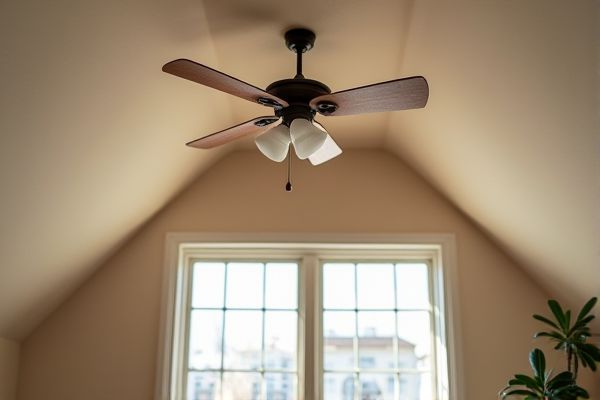
Choosing between a ceiling fan and a wall fan for your attic depends on factors like space, airflow needs, and installation ease; ceiling fans provide broader air circulation while wall fans are ideal for targeted ventilation in tighter spots. Explore the rest of this article to discover which option best suits your attic cooling requirements.
Table of Comparison
| Feature | Ceiling Fan | Wall Fan (Attic) |
|---|---|---|
| Installation Location | Mounted on ceiling | Mounted on attic wall |
| Air Circulation | Wide, 360deg room coverage | Focused airflow in attic spaces |
| Ideal Use | Living rooms, bedrooms, general cooling | Ventilation and heat extraction in attics |
| Space Saving | Leaves floor and wall space free | Requires wall space, saves ceiling space |
| Power Consumption | Generally low to moderate | Can vary; designed for attic ventilation |
| Noise Level | Typically quiet | May produce more noise due to powerful motors |
| Maintenance | Easy to clean blades, occasional motor check | Requires periodic cleaning and motor check |
| Cost | Moderate price range | Varies; often higher for heavy-duty attic fans |
Overview: Ceiling Fan vs Wall Fan in Attics
Ceiling fans in attics provide efficient air circulation by promoting even airflow and reducing heat buildup near the ceiling, making them ideal for larger, open spaces. Wall fans offer targeted ventilation and are easier to install in confined attic areas where ceiling fan installation is impractical. Choosing between the two depends on attic size, airflow needs, and installation constraints, with ceiling fans enhancing overall attic temperature regulation and wall fans improving localized air movement.
Space Efficiency: Which Fan Fits Your Attic?
Ceiling fans optimize space by being mounted overhead, leaving floor and wall areas clear, ideal for attics with limited floor space but sufficient ceiling height. Wall fans are space-efficient for attics with low ceilings or obstructed overhead areas, as they do not require floor or ceiling clearance. Choosing between the two depends on attic dimensions and airflow needs, with ceiling fans preferred for open, tall attics and wall fans suited for compact, confined spaces.
Installation Complexity and Requirements
Ceiling fans require secure mounting to ceiling joists and often involve electrical wiring within ceilings, making installation moderately complex and potentially needing professional assistance. Wall fans designed for attics typically have simpler installation processes with mounting brackets and are easier to connect to existing power sources, reducing time and effort. When selecting your attic fan, consider the structural support and electrical expertise needed for ceiling fans versus the straightforward setup of wall fans.
Airflow and Circulation Performance
Ceiling fans provide superior airflow and circulation performance by distributing air evenly across larger spaces, ideal for attic environments where heat tends to accumulate near the ceiling. Wall fans focus airflow in a specific area, which can be effective for targeted cooling but may result in uneven air distribution and less efficient overall ventilation in attics. Your choice depends on whether you prioritize broad air circulation or localized airflow control.
Energy Consumption and Cost
Ceiling fans typically consume between 15 to 90 watts depending on size and speed settings, offering energy savings in attic spaces by circulating air efficiently and reducing heating or cooling costs. Wall fans generally use slightly less power, around 40 to 70 watts, but may not provide as uniform airflow as ceiling fans, potentially increasing reliance on HVAC systems. Choosing energy-efficient models with DC motors and variable speed controls can further reduce electricity costs for both ceiling and wall fans in attic applications.
Noise Levels and Operation Comfort
Ceiling fans in attics typically produce lower noise levels due to their stable mounting and balanced blades, ensuring smoother air circulation and operation comfort. Wall fans often generate more noise because of vibrations from less secure mounting and higher motor speeds needed to circulate air in confined attic spaces. Choosing a ceiling fan can enhance your comfort by providing quieter, consistent airflow with less operational disturbance.
Safety Considerations in Attic Settings
Ceiling fans in attic spaces require secure mounting to joists and sufficient clearance from rafters to prevent accidents, while wall fans must be installed on sturdy, vibration-resistant surfaces to avoid detachment. Electrical wiring for both fan types should comply with local building codes to reduce fire hazards, especially in confined attic areas with limited ventilation. Proper maintenance of fan blades and motor housing is critical to ensure safe operation and prevent overheating in attic environments.
Maintenance and Durability
Ceiling fans typically require less frequent maintenance due to their elevated position, which minimizes dust accumulation and damage risks compared to wall fans installed in attics. Wall fans in attics face harsher environmental conditions like heat and dust, necessitating more regular cleaning and inspections to ensure durability. Durable materials such as rust-resistant metals and sealed motor housings improve the lifespan of both fan types, but ceiling fans generally offer longer-term reliability with standard upkeep.
Aesthetic Impact and Design Options
Ceiling fans in attics offer a sleek, integrated look that complements varied interior styles while maximizing floor space, making them ideal for maintaining an open, uncluttered environment. Wall fans provide more flexibility in placement and are available in numerous designs, allowing you to highlight architectural features or save room in compact areas. Your choice between the two should consider how each design option aligns with your attic's aesthetic appeal and functional needs.
Choosing the Right Fan for Your Attic Needs
Ceiling fans provide superior air circulation for larger attic spaces by distributing airflow evenly and maintaining a consistent temperature, making them ideal for well-insulated attics. Wall fans are better suited for smaller or irregularly shaped attics, offering targeted ventilation and easy installation without taking up ceiling space. Selecting the right fan depends on attic size, insulation quality, and airflow requirements to enhance energy efficiency and comfort.
 homyna.com
homyna.com